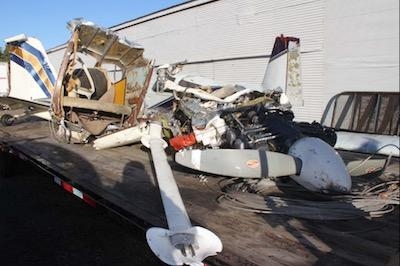Wed, May 16, 2018
Board Finds The Pilot Flew Too Low Before Impacting Power Lines And The Mississippi River
The NTSB has released its probable cause report from an accident which occurred October 13 last year that resulted in the fatal injury of the Cessna 172 pilot and his wife, who was a passenger in the airplane.

According to the report, the Cessna 172M airplane, N7CF, was destroyed during an in-flight collision with power lines and the Mississippi River near Ramsey, Minnesota. The NTSB concluded that after takeoff, the pilot proceeded south until reaching the Mississippi River when he proceeded to fly along the river at a low altitude. As the airplane approached a bend in the river, the pilot entered a shallow left turn to follow the river. The airplane subsequently struck power lines spanning the river that were located about 200 yards beyond the bend. Ground-based video footage and witness statements indicated that the airplane was at or below the height of the trees lining both sides of the river shortly before encountering the power lines. One witness initially thought that the pilot intended to fly under the power lines due to the low altitude of the airplane. Several witnesses also noted that the sound of the engine seemed normal and steady before the accident. A post-recovery examination of the
airplane did not reveal any anomalies consistent with a preimpact failure or malfunction.
The power lines were below the level the trees on either side of the river. Red aerial marker balls were installed on the power lines at the time of the accident. Weather conditions were good at the time of the accident; however, the sun was about 9° above the horizon and aligned with the river. It is likely that the position of the sun in relation to the power lines hindered the pilot's ability to identify the hazard as he navigated the bend in the river at low altitude. In addition, the location of the power lines relative to the river bend minimized the reaction time to avoid the lines.
FAA regulations prohibit operation of an aircraft less than 500 feet above the surface in uncongested areas unless approaching to land or taking off, and at least 1,000 feet from obstacles in congested areas. They also prohibit operations in a reckless manner that endanger the life or property of another. Based on the available information, the airplane was less than 100 feet above the river and within 400 feet of the residences located along the river during the final portion of the flight.
The pilot's flight instructor described the pilot as "reckless" because of his habit of low-level flying.

While the location of the bend in the river and the position of the sun relative to the power lines may have hindered the pilot's ability to see and avoid the lines, it was the pilot's decision to operate the airplane along the river at a low altitude contrary to applicable regulations and safety of flight considerations that caused the accident.
The NTSB determined the probable cause of this accident to be the pilot's decision to fly along the river at a low altitude contrary to applicable regulations and safety of flight considerations which resulted in the impact with the power lines. Contributing to the accident was the pilot's inability to see the and avoid the power lines due to their proximity to a bend in the river and the position of the sun at the time of the accident.
(Source: NTSB. Images from accident docket)
More News
19-Year-Old Pilot Was Attempting to Fly Solo to All Seven Continents On his journey to become the first pilot to land solo on all seven continents, 19-year-old Ethan Guo has hit a >[...]
From 2017 (YouTube Edition): A Quality LSA For Well Under $100k… Aeroprakt unveiled its new LSA at the Deland Sport Aviation Showcase in November. Dennis Long, U.S. Importer>[...]
Hazardous Weather Information Summary of significant meteorological information (SIGMET/WS), convective significant meteorological information (convective SIGMET/WST), urgent pilot>[...]
Aero Linx: Historic Aircraft Association (HAA) The Historic Aircraft Association (HAA) was founded in 1979 with the aim of furthering the safe flying of historic aircraft in the UK>[...]
"We would like to remember Liam not just for the way he left this world, but for how he lived in it... Liam was fearless, not necessarily because he wasn't afraid but because he re>[...]
 TikToker Arrested After Landing His C182 in Antarctica
TikToker Arrested After Landing His C182 in Antarctica Classic Aero-TV: Versatile AND Practical - The All-Seeing Aeroprakt A-22 LSA
Classic Aero-TV: Versatile AND Practical - The All-Seeing Aeroprakt A-22 LSA ANN's Daily Aero-Term (06.27.25): Hazardous Weather Information
ANN's Daily Aero-Term (06.27.25): Hazardous Weather Information ANN's Daily Aero-Linx (06.27.25)
ANN's Daily Aero-Linx (06.27.25) Aero-News: Quote of the Day (06.27.25)
Aero-News: Quote of the Day (06.27.25)




